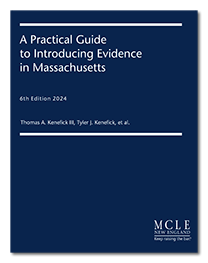A Practical Guide to Introducing Evidence in Massachusetts
Trusted guidance for every stage of your trial

- Product Number: 1870081B00
- Publication Date: 7/8/2024
- Edition: 6th Edition 2024
- Copyright: © 2024 MCLE, Inc.
-
Add to Favorites List
Choose Format:
-
Product Description
Product Description
A Practical Guide to Introducing Evidence in Massachusetts is a convenient reference for identifying the foundational requirements and examination techniques that apply to introducing evidence at trial. Sample examinations illustrate the practical implementation of each of the evidentiary approaches explored in the text.
The Practical Guide addresses some eighty evidentiary areas, from admissions to X-rays. And it offers tips and guidelines for handling established categories of evidence—prior convictions, privileges, hearsay—as well as timely topics such as genetic marker testing, "first complaint" evidence, Daubert/Lanigan standards, and electronic evidence such as Web pages and e-mail.
Recent updates:
-
Update: July 2024
Dear Subscriber:
Thank you for choosing to keep your evidence library current with this 2024 edition of A Practical Guide to Introducing Evidence in Massachusetts . In this revised edition, you will find practical discussion, case law, and insights on topics such as the following:
- Preserving the record for appeal. See chapter 4 for a suggestion regarding making offers of proof to fill in gaps following a ruling on motions in limine. A 2023 case decision is cited. The chapter also offers a 2023 case pertinent to the use of motions in limine in criminal cases, where they can serve as a method for seeking a ruling on the admissibility of prior convictions.
- Witness incompetency. Chapter 5 discusses practical considerations inherent in the use of voir dire as a tool to challenge a witness's competence.
- Fresh complaint. Chapter 6 offers a 2024 case decision where a modified version of the "fresh complaint" doctrine, known as the "first complaint" doctrine, is addressed.
- Character witnesses. In chapter 8, there is an updated sample examination in which a defendant in a criminal case is questioning a character witness.
- Prior conviction. Chapter 9 includes discussion of a 2024 decision addressing facts where a prior conviction is of the same or a very similar crime to the one being alleged at trial, and admissibility issues where the prejudicial effect of its admission outweighs its probative value.
- "Testimonial" statements. See chapter 12 for discussion of litigation on "testimonial" statements, those made under circumstances that would lead an objective witness reasonably to believe that the statement would be available for use at a later trial. The chapter refers to a primary purpose test to determine whether a statement is testimonial or nontestimonial and offers a 2023 case on the topic.
We at MCLE trust that you'll find this new material useful in your law practice, and valuable in keeping your practical reference library current.
Cordially,
MCLE Press
-
Update: July 2024
-
Table of Contents
Table of Contents
expand allChapter 01 expandA Practical Introduction to Pretrial and Trial Practice
Buy Chapter Chapter 02 expand
Chapter 02 expandIntroduction of Evidence
Buy Chapter
Checklist 2.1
- Practical Suggestions for Organizing Your Presentation of Evidence Buy FormChapter 03 expandPresumptions and Facts Established Without Formal Proof
Buy Chapter Chapter 04 expand
Chapter 04 expandEvidentiary Exclusions and Limitations
Buy Chapter Chapter 05 expand
Chapter 05 expandWitness Competency and Qualifications
Buy Chapter Chapter 06 expand
Chapter 06 expandWitness Corroboration and Support
Buy Chapter Chapter 07 expand
Chapter 07 expandIdentification
Buy Chapter Chapter 08 expand
Chapter 08 expandReputation
Buy Chapter Chapter 09 expand
Chapter 09 expandImpeachment
Buy Chapter Chapter 10 expand
Chapter 10 expandRehabilitation
Buy Chapter Chapter 11 expand
Chapter 11 expandPrivilege and Disqualification
Buy Chapter Chapter 12 expand
Chapter 12 expandHearsay Exceptions Involving State of Mind
Buy Chapter Chapter 13 expand
Chapter 13 expandDocumentary Evidence
Buy Chapter Chapter 14 expand
Chapter 14 expandDemonstrative Evidence
Buy Chapter
- Editors & Authors

